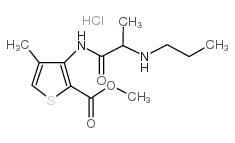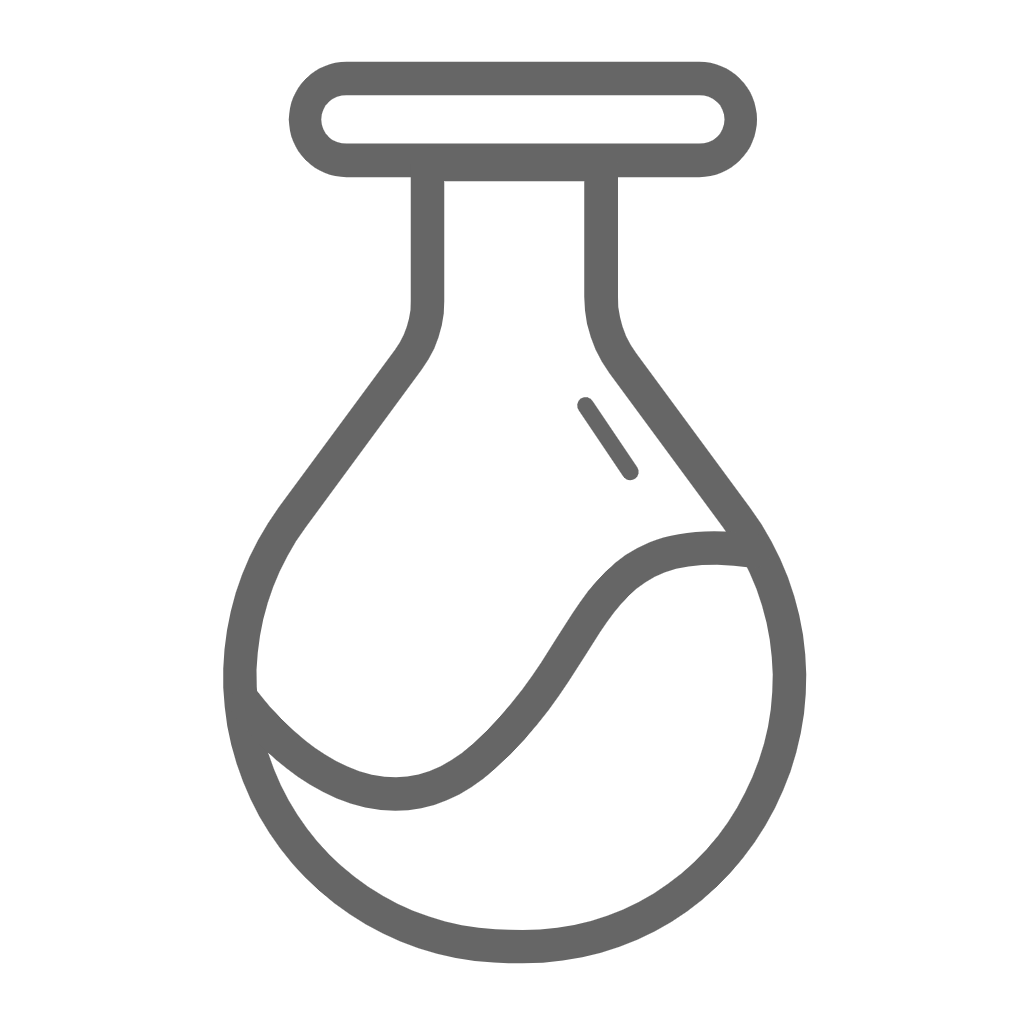咨询热线:400-678-7252
客诉专线:400-811-5300
全部产品分类

| 盐酸阿替卡因 基本信息 | |||
|---|---|---|---|
| CAS号 | 23964-57-0 | 分子式 | C13H21ClN2O3S |
| 分子量 | 320.83500 | 精确质量 | 320.09600 |
| PSA | 95.67000 | LogP | 3.43560 |

 基础参数
基础参数
 凯茵合作品牌
凯茵合作品牌
 毒理学数据
毒理学数据
CHEMICAL IDENTIFICATION
RTECS NUMBER :XM8511000
CHEMICAL NAME :2-Thiophenecarboxylic acid, 4-methyl-3-(2-(propylamino)propionamido)-, methyl ester, monohydrochloride
CAS REGISTRY NUMBER :23964-57-0
LAST UPDATED :198412
DATA ITEMS CITED :1
MOLECULAR FORMULA :C13-H20-N2-O3-S.Cl-H
MOLECULAR WEIGHT :320.87
WISWESSER LINE NOTATION :T5SJ BVO1 CMVY1&M3 D1 &GH
HEALTH HAZARD DATA
ACUTE TOXICITY DATA
TYPE OF TEST :LD50 - Lethal dose, 50 percent kill
ROUTE OF EXPOSURE :Intravenous
SPECIES OBSERVED :Rodent - mouse
DOSE/DURATION :37 mg/kg
TOXIC EFFECTS :Details of toxic effects not reported other than lethal dose value
REFERENCE :PAWIAT Praktische Anaesthesie, Wiederbelegung und Intensivtherapie. (Stuttgart, Fed. Rep. Ger.) V.9-14, 1974-79. Volume(issue)/page/year: 9,135,1974
 凯茵主营品类
凯茵主营品类
 MSDS
MSDS
SECTION 1: Identification of the substance/mixture and of the company/undertaking
Product identifiers
Product name: Articaine hydrochloride
REACH No.: A registration number is not available for this substance as the substance
or its uses are exempted from registration, the annual tonnage does not
require a registration or the registration is envisaged for a later
registration deadline.
CAS-No.: 23964-57-0
Relevant identified uses of the substance or mixture and uses advised against
Identified uses: Laboratory chemicals, Manufacture of substances
SECTION 2: Hazards identification
Classification of the substance or mixture
Classification according to Regulation (EC) No 1272/2008
Skin irritation (Category 2), H315
Eye irritation (Category 2), H319
Specific target organ toxicity - single exposure (Category 3), Respiratory system, H335
For the full text of the H-Statements mentioned in this Section, see Section 16.
Classification according to EU Directives 67/548/EEC or 1999/45/EC
Xi IrritantR36/37/38
For the full text of the R-phrases mentioned in this Section, see Section 16.
Label elements
Labelling according Regulation (EC) No 1272/2008
Pictogram
Signal wordWarning
Hazard statement(s)
H315Causes skin irritation.
H319Causes serious eye irritation.
H335May cause respiratory irritation.
Precautionary statement(s)
P261Avoid breathing dust.
P305 + P351 + P338IF IN EYES: Rinse cautiously with water for several minutes. Remove
contact lenses, if present and easy to do. Continue rinsing.
Supplemental Hazardnone
Statements
Other hazards - none
SECTION 3: Composition/information on ingredients
Substances
Synonyms: Carticaine chlorhydrate
Carticaine hydrochloride
4-Methyl-3-[[1-oxo-2-(propylamino)propyl]amino]-2-thiophenecarboxylic
acid methyl ester hydrochloride
Formula: C13H20N2O3S . HCl
Molecular Weight: 320,84 g/mol
CAS-No.: 23964-57-0
EC-No.: 245-957-7
Hazardous ingredients according to Regulation (EC) No 1272/2008
ComponentClassificationConcentration
methyl 4-methyl-3-[[(1-oxo-2-(propylamino)propyl]amino]-2-thenoate monohydrochloride
CAS-No.23964-57-0Skin Irrit. 2; Eye Irrit. 2; STOT <= 100 %
EC-No.245-957-7SE 3; H315, H319, H335
Hazardous ingredients according to Directive 1999/45/EC
ComponentClassificationConcentration
methyl 4-methyl-3-[[(1-oxo-2-(propylamino)propyl]amino]-2-thenoate monohydrochloride
CAS-No.23964-57-0Xi, R36/37/38<= 100 %
EC-No.245-957-7
For the full text of the H-Statements and R-Phrases mentioned in this Section, see Section 16
SECTION 4: First aid measures
Description of first aid measures
General advice
Consult a physician. Show this safety data sheet to the doctor in attendance.
If inhaled
If breathed in, move person into fresh air. If not breathing, give artificial respiration. Consult a physician.
In case of skin contact
Wash off with soap and plenty of water. Consult a physician.
In case of eye contact
Rinse thoroughly with plenty of water for at least 15 minutes and consult a physician.
If swallowed
Never give anything by mouth to an unconscious person. Rinse mouth with water. Consult a physician.
Most important symptoms and effects, both acute and delayed
The most important known symptoms and effects are described in the labelling (see section 2.2) and/or in
section 11
Indication of any immediate medical attention and special treatment needed
no data available
SECTION 5: Firefighting measures
Extinguishing media
Suitable extinguishing media
Use water spray, alcohol-resistant foam, dry chemical or carbon dioxide.
Special hazards arising from the substance or mixture
no data available
Advice for firefighters
Wear self contained breathing apparatus for fire fighting if necessary.
Further information
no data available
SECTION 6: Accidental release measures
Personal precautions, protective equipment and emergency procedures
Use personal protective equipment. Avoid dust formation. Avoid breathing vapours, mist or gas. Ensure
adequate ventilation. Evacuate personnel to safe areas. Avoid breathing dust.
For personal protection see section 8.
Environmental precautions
Do not let product enter drains.
Methods and materials for containment and cleaning up
Pick up and arrange disposal without creating dust. Sweep up and shovel. Keep in suitable, closed
containers for disposal.
Reference to other sections
For disposal see section 13.
SECTION 7: Handling and storage
Precautions for safe handling
Avoid contact with skin and eyes. Avoid formation of dust and aerosols.
Provide appropriate exhaust ventilation at places where dust is formed.
For precautions see section 2.2.
Conditions for safe storage, including any incompatibilities
Store in cool place. Keep container tightly closed in a dry and well-ventilated place.
Recommended storage temperature: 2 - 8 °C
Store with desiccant.
Specific end use(s)
Apart from the uses mentioned in section 1.2 no other specific uses are stipulated
SECTION 8: Exposure controls/personal protection
Control parameters
Components with workplace control parameters
Exposure controls
Appropriate engineering controls
Handle in accordance with good industrial hygiene and safety practice. Wash hands before breaks and
at the end of workday.
Personal protective equipment
Eye/face protection
Safety glasses with side-shields conforming to EN166 Use equipment for eye protection tested
and approved under appropriate government standards such as NIOSH (US) or EN 166(EU).
Skin protection
Handle with gloves. Gloves must be inspected prior to use. Use proper glove removal technique
(without touching glove's outer surface) to avoid skin contact with this product. Dispose of
contaminated gloves after use in accordance with applicable laws and good laboratory practices.
Wash and dry hands.
The selected protective gloves have to satisfy the specifications of EU Directive 89/686/EEC and
the standard EN 374 derived from it.
Body 手感助剂ion
impervious clothing, The type of protective equipment must be selected according to the
concentration and amount of the dangerous substance at the specific workplace.
Respiratory protection
For nuisance exposures use type P95 (US) or type P1 (EU EN 143) particle respirator.For higher
level protection use type OV/AG/P99 (US) or type ABEK-P2 (EU EN 143) respirator cartridges.
Use respirators and components tested and approved under appropriate government standards
such as NIOSH (US) or CEN (EU).
Control of environmental exposure
Do not let product enter drains.
SECTION 9: Physical and chemical properties
Information on basic physical and chemical properties
a) AppearanceForm: solid
b) Odourno data available
c) Odour Thresholdno data available
d) pHno data available
e) Melting point/freezingno data available
point
f) Initial boiling point and no data available
boiling range
g) Flash pointno data available
h) Evapouration rateno data available
i) Flammability (solid, gas) no data available
j) Upper/lowerno data available
flammability or
explosive limits
k) Vapour pressureno data available
l) Vapour densityno data available
m) Relative densityno data available
n) Water solubilityno data available
o) Partition coefficient: n- no data available
octanol/water
p) Auto-ignitionno data available
temperature
q) Decompositionno data available
temperature
r) Viscosityno data available
s) Explosive propertiesno data available
t) Oxidizing propertiesno data available
Other safety information
no data available
SECTION 10: Stability and reactivity
Reactivity
no data available
Chemical stability
Stable under recommended storage conditions.
Possibility of hazardous reactions
no data available
Conditions to avoid
no data available
Incompatible materials
Strong oxidizing agents
Hazardous decomposition products
Other decomposition products - no data available
Hazardous decomposition products formed under fire conditions. - Carbon oxides, nitrogen oxides (NOx),
Sulphur oxides, Hydrogen chloride gas
In the event of fire: see section 5
SECTION 11: Toxicological information
Information on toxicological effects
Acute toxicity
no data available
Skin corrosion/irritation
no data available
Serious eye damage/eye irritation
no data available
Respiratory or skin sensitisation
no data available
Germ cell mutagenicity
no data available
Carcinogenicity
IARC:No component of this product present at levels greater than or equal to 0.1% is identified as
probable, possible or confirmed human carcinogen by IARC.
Reproductive toxicity
no data available
Specific target organ toxicity - single exposure
no data available
Specific target organ toxicity - repeated exposure
no data available
Aspiration hazard
no data available
Additional Information
RTECS: Not available
To the best of our knowledge, the chemical, physical, and toxicological properties have not been
thoroughly investigated.
SECTION 12: Ecological information
Toxicity
no data available
Persistence and degradability
no data available
Bioaccumulative potential
no data available
Mobility in soil
no data available
Results of PBT and vPvB assessment
PBT/vPvB assessment not available as chemical safety assessment not required/not conducted
Other adverse effects
no data available
SECTION 13: Disposal considerations
Waste treatment methods
Product
Offer surplus and non-recyclable solutions to a licensed disposal company. Dissolve or mix the material
with a combustible solvent and burn in a chemical incinerator equipped with an afterburner and scrubber.
Contaminated packaging
Dispose of as unused product.
SECTION 14: Transport information
UN number
ADR/RID: -IMDG: -IATA: -
UN proper shipping name
ADR/RID: Not dangerous goods
IMDG: Not dangerous goods
IATA:Not dangerous goods
Transport hazard class(es)
ADR/RID: -IMDG: -IATA: -
Packaging group
ADR/RID: -IMDG: -IATA: -
Environmental hazards
ADR/RID: noIMDG Marine pollutant: noIATA: no
Special precautions for user
no data available
SECTION 15: Regulatory information
This safety datasheet complies with the requirements of Regulation (EC) No. 1907/2006.
Safety, health and environmental regulations/legislation specific for the substance or mixture
no data available
Chemical Safety Assessment
For this product a chemical safety assessment was not carried out
SECTION 16: Other information
Full text of H-Statements referred to under sections 2 and 3.
Eye Irrit.Eye irritation
H315Causes skin irritation.
H319Causes serious eye irritation.
H335May cause respiratory irritation.
Skin Irrit.Skin irritation
STOT SESpecific target organ toxicity - single exposure
Full text of R-phrases referred to under sections 2 and 3
XiIrritant
R36/37/38Irritating to eyes, respiratory system and skin.
Further information
Copyright 2014 Co. LLC. License granted to make unlimited paper copies for internal use
only.
The above information is believed to be correct but does not purport to be all inclusive and shall be
used only as a guide. The information in this document is based on the present state of our knowledge
and is applicable to the product with regard to appropriate safety precautions. It does not represent any
guarantee of the properties of the product. Corporation and its Affiliates shall not be held
liable for any damage resulting from handling or from contact with the above product. See
and/or the reverse side of invoice or packing slip for additional terms and conditions of sale.
声明:该栏目及页面中图片、产品参数数据来源于互联网,仅供用于参考了解化学品信息,不等同凯茵化工实际销售产品。
颜料黄BH-R4005-08
DPP红-D2005-08
喹吖啶酮红117105-08
杜邦树脂 FUSABOND®P35306-16
环氧防火涂料的性能04-07
我国碳黑的市场及现状08-28
消光粉在涂料中的地位在日益提高08-12
钛白粉调价,引起业内不少人士的关注05-22